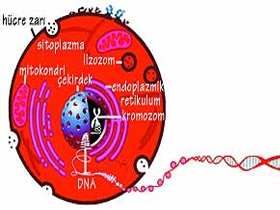Popular scientific terminology is often used to apply an authoritative veneer to evolution. Evolutionists make use of "DNA" in just this way.
In addition to being present in the nucleus, DNA is also found in mitochondria, energy-production organelles in the cell. The DNA in the nucleus forms as a result of the combination of DNA from the mother and father, but the mother is the sole source of the mitochondrial DNA. Every human being's mitochondrial DNA is therefore identical to his or her mother's, and therefore, the origin of man can be researched by following this trail.
The "mitochondrial Eve" thesis distorts this fact by interpreting it according to the dogmas of the theory of evolution. A few evolutionist scientists have regarded the mitochondrial DNA of the first humanoid as the DNA of chimpanzees, by viewing as indisputable scientific fact the claim that the chimpanzee is man's ancestor. Over hundreds of thousands of years, according to this claim, random mutations turned chimpanzee DNA into our present mitochondrial DNA. Starting from that preconception, they then attempted to determine where and when the present evolutionary family tree began.

The Berkeley University biochemists Wilson, Cann and Stoneking, who first proposed the theory, set out with fundamental assumptions that were impossible to prove:
1. The origin of mitochondrial DNA lies in hominids, in other words ape-like creatures.
2. Mutations must have caused regular changes in mitochondrial DNA.
3. These mutations must have taken place constantly and at a fixed rate.
Taking these assumptions as their basis, the researchers believed that they could obtain a molecular clock to show how quickly a species changed within the alleged process of evolution. In fact, the writers of the computer program to calculate that clock directed their research towards the result they wished to achieve.
The assumptions they worked on were claims whose existence could not be proven, of which no examples had ever been obtained by experiment or observation. Mutations, caused by degeneration of DNA, have only been observed to cause deformity and death in living structures. Mutations can never impart progress by raising a living thing to a higher level. (See Mutation: An Imaginary Mechanism.)
The evolutionist researchers developed a computer program that they hoped would camouflage their prejudices. They created their program on the basis of evolution, following the most direct and effective path. This, however, is an imaginary picture that conflicts with even the basic assumptions of the theory of evolution.
Many scientists who supported the theory of evolution agreed that this thesis had no scientific value. Henry Gee, a member of Nature magazine's editorial board, described the results of the MtDNA (mitochondrial DNA) study as garbage49 in an article titled "Statistical Cloud over African Eden." In his article, Gee stated that when the current 136 MtDNA series were considered, the number of family trees exceeded 1 billion! In other words, in this study, these 1 billion chance family trees were ignored, and only that one tree compatible with the hypothesis of evolution between chimpanzees and human beings was selected.
Alan Templeton, the well-known Washington University biologist, stated that it was impossible to set out any date for the origin of man based on DNA series, because DNA was highly mixed up, even in present human societies.50
Considered in mathematical terms, it means that it is impossible to determine mtDNA as belonging to a single human being in the family tree.
The most significant admission came from the authors of the thesis themselves. Mark Stoneking, from the team that repeated the study in 1992, said in a letter to Science magazine that the "African Eve" thesis was untenable,51 because it was clear that in all respects, the study had been aimed towards the desired result.
The mitochondrial DNA thesis was developed on the basis of mutations in DNA. But when the evolutionists looked at human DNA, it was unclear how they decided which DNA rungs had formed as the result of mutation, and which were original and unchanged. They had to start work from the original human DNA they claim must have existed. Yet the evolutionist deception here is crystal-clear: They assumed chimpanzee DNA as their basis.52
To put it another way, in a study looking for evidence that chimpanzee DNA turned into human DNA, the chimpanzee is taken as the starting point as the original prehistoric human. Right from the outset, the study is carried out on the assumption that evolution took place, and the result obtained is then depicted as proof of evolution. In these circumstances, the study is far from being scientific.
In addition, if an evolutionist researcher is to employ regular, useful mutations that he claims occurred in DNA in calculating the molecular clock, then he must also calculate the speed of these mutations. Yet there is not the slightest indication, in either the nucleus of the mitochondria, to show the frequency with which DNA was subjected to mutation.
In terms of its own logic, this thesis actually shows that once again, there has been an attempt to use evolution as evidence for evolution. Seeking evidence for evolution in DNA is biased research, based on the assumption that evolution took place in any case.
Why do evolutionists feel the need to pull the wool over people's eyes in this way? The answer is clear: Because there is no scientific evidence to support evolution.
49. Henry Gee, "Statistical Cloud over African Eden," Nature, Vol. 355, February 13, 1992, p. 583
50. Marcia Barinaga, " ‘African Eve' Backers Beat a Retreat," Science, 255, February 7, 1992, p. 687.
51. S. Blair Hedges, Sudhir Kumar, Koichiro Tamura, and Mark Stoneking, "Human Origins and Analysis of Mitochondrial DNA Sequences," Science, 255, 7 February 1992, pp. 737-739.
52. Barinaga, "Choosing a Human Family Tree," Science, 255, 7 February 1992, p. 687.


